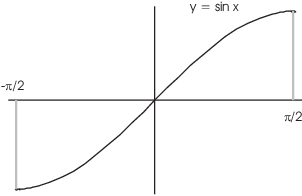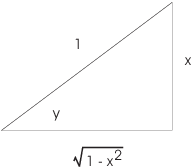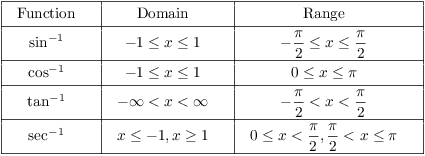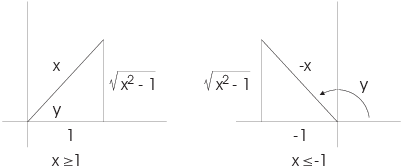If you restrict ![]() to the interval
to the interval ![]() , the function
increases:
, the function
increases:

This implies that the function is one-to-one, and hence it
has an inverse. The inverse is called the inverse
sine or arcsine function, and is denoted
![]() or
or ![]() . Note that
in the second case
. Note that
in the second case ![]() does not
mean "
does not
mean "![]() "!
"!
Note: "Arcsine" (and ![]() ) are older
terms, and there is similar terminology for the other inverse trig
functions (so "arctangent" and
) are older
terms, and there is similar terminology for the other inverse trig
functions (so "arctangent" and ![]() for the inverse tangent function, and so
on). I'll use the inverse function terminology instead.
for the inverse tangent function, and so
on). I'll use the inverse function terminology instead.
In word, ![]() is the angle whose sine is
x. Another way of saying this is:
is the angle whose sine is
x. Another way of saying this is:
![]()
The fact that ![]() and
and ![]() are inverse functions can be expressed by
the following equations:
are inverse functions can be expressed by
the following equations:
![]()
![]()
Since the restricted ![]() takes angles in the
range
takes angles in the
range ![]() and
produces numbers in the range
and
produces numbers in the range ![]() ,
, ![]() takes numbers in the range
takes numbers in the range ![]() and produces angles in the range
and produces angles in the range ![]() .
.

Example. Compute ![]() and
and ![]() .
.
![]()
![]()
Sine and arcsine are inverses, so they undo one another --- but you have to be careful!
![]()
![]() can't be
can't be ![]() , because
, because ![]() always returns
an angle in the range
always returns
an angle in the range ![]() .
.![]()
Example. Find ![]() .
.
First, let ![]() . This
means that
. This
means that ![]() . Now
. Now ![]() , so
I get the following picture:
, so
I get the following picture:

I got the adjacent side using Pythagoras: ![]() .
.
Using the triangle, I have
![]()
You can find a derivative formula for ![]() using implicit differentiation. Let
using implicit differentiation. Let ![]() . This is equivalent to
. This is equivalent to ![]() . Differentiate implicitly:
. Differentiate implicitly:

I'd like to express the result in terms of x. Here's the right
triangle that says ![]() :
:

I found the other leg using Pythagoras. You can see that ![]() . Hence,
. Hence, ![]() . That is,
. That is,
![]()
Every derivative formula gives rise to a corresponding antiderivative formula:
![]()
Before I do some calculus examples, I want to mention some of the other inverse trig functions. I'll discuss the inverse cosine, inverse tangent, and inverse secant functions.
(a) You get the inverse cosine by inverting ![]() , restricted to
, restricted to ![]() .
.

(b) You get the inverse tangent by inverting ![]() , restricted to
, restricted to ![]() .
.

(c) You get the inverse secant by inverting ![]() , restricted to
, restricted to ![]() together with
together with ![]() .
.

As with ![]() and
and ![]() , the domains
and ranges of these functions and their inverses are
"swapped":
, the domains
and ranges of these functions and their inverses are
"swapped":

Example. Compute ![]() and
and ![]() .
.
![]()
![]()
You can derive the derivative formulas for the other inverse trig functions using implicit differentiation, just as I did for the inverse sine function.
![]()
![]()
![]()
For example, I'll derive the formula for ![]() .
.
The derivation starts out like the derivation for ![]() . Let
. Let ![]() , so
, so ![]() . Differentiating implicitly, I get
. Differentiating implicitly, I get

There are two cases, depending on whether ![]() or
or ![]() .
.

Suppose ![]() . Then
. Then ![]() is in the interval
is in the interval ![]() , as illustrated in the first
diagram above. You can see from the picture that
, as illustrated in the first
diagram above. You can see from the picture that
![]()
Therefore,
![]()
![]() , so x is positive, and
, so x is positive, and ![]() . Therefore,
. Therefore,
![]()
Now suppose that ![]() . Then
. Then ![]() is in the interval
is in the interval ![]() , as illustrated in the second
diagram above. Since x is negative, the hypotenuse must be
, as illustrated in the second
diagram above. Since x is negative, the hypotenuse must be ![]() , since it must be positive and since
, since it must be positive and since ![]() must equal x. In this case,
must equal x. In this case,
![]()
Therefore,
![]()
![]() , so x is negative, and
, so x is negative, and ![]() . Therefore,
. Therefore,
![]()
This proves that ![]() in
all cases.
in
all cases.
Example. Compute:
(a) ![]() .
.
(b) ![]() .
.
(c) ![]() .
.
(a)
![]()
(b)
![]()
(c)
![]()
I don't need absolute values in the last example, because ![]() is always positive.
is always positive.
Example. Prove the identity
![]()

Hence,
![]()
A function with zero derivative is constant, so
![]()
But when ![]() ,
,
![]()
Therefore,
![]()
Here are the integration formulas for some of the inverse trig
functions. I'm giving extended versions of the formulas --- with
"![]() " replacing the "1" that
you'd get if you just reversed the derivative formulas --- in order
to save you a little time in doing problems.
" replacing the "1" that
you'd get if you just reversed the derivative formulas --- in order
to save you a little time in doing problems.
![]()
![]()
![]()
For instance, here's how to derive the extended ![]() integral formula from the formula
integral formula from the formula ![]() using substitution:
using substitution:

![]()
Example. Compute ![]() and
and ![]() .
.
Using the ![]() formula with
formula with ![]() ,
,
![]()
Using the ![]() formula with
formula with ![]() ,
,
![]()
Example. Compute ![]() .
.
![]()
![]()
Example. Compute ![]() .
.
![]()
![]()
![]()
Example. Compute ![]() .
.
![]()
![]()
Example. Compute ![]() .
.
![]()
![]()
Copyright 2018 by Bruce Ikenaga